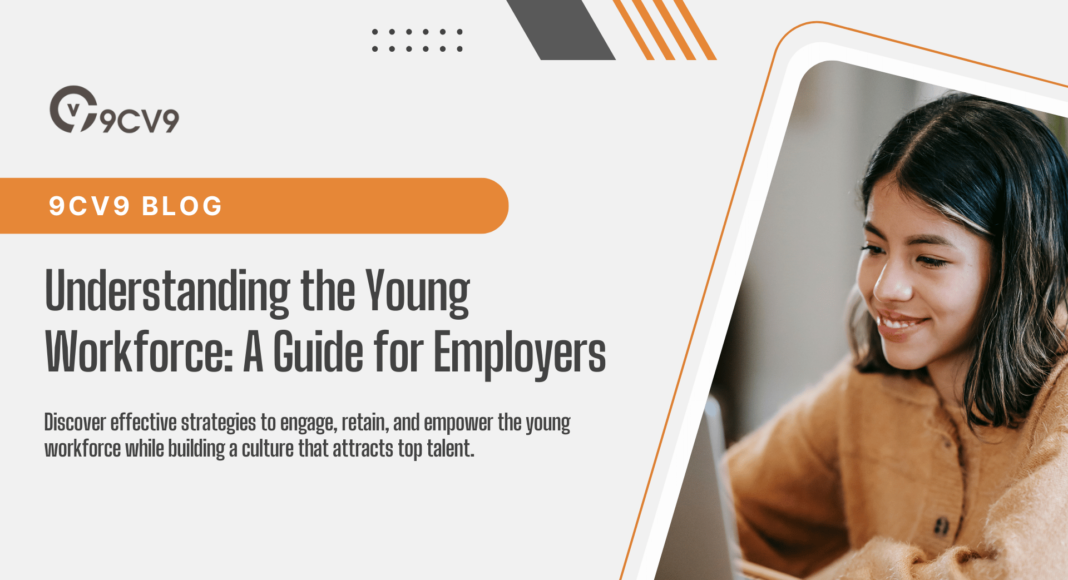Key Takeaways
- Engage Millennials and Gen Z by aligning company culture with their values – Prioritize purpose-driven work, flexibility, and well-being to attract and retain top young talent.
- Adapt leadership styles to foster collaboration and innovation – Use empathetic, transparent, and inclusive leadership approaches to empower the younger workforce.
- Invest in career development and mentorship programs – Offer growth opportunities, continuous feedback, and tailored learning experiences to drive employee satisfaction and long-term success.
The workplace is evolving rapidly, driven by technological advancements, globalization, and shifting societal norms.
At the center of this transformation is the emergence of a young and dynamic workforce comprising millennials and Generation Z.
As these generations now dominate the labor market, employers must adapt to their unique expectations, values, and working styles.
Failing to understand the younger workforce can lead to miscommunication, disengagement, and high turnover rates.
On the other hand, organizations that successfully align with their needs stand to gain innovative ideas, increased productivity, and a thriving workplace culture.

The young workforce is redefining what it means to work in the modern era.
Unlike previous generations, they prioritize flexibility, inclusivity, and purpose over traditional notions of job security and hierarchical structures.
They seek employers who value their input, provide meaningful growth opportunities, and embrace technology as an enabler of success.
For companies aiming to attract and retain top talent, understanding these nuances is no longer optional—it’s a strategic necessity.
This guide delves into the key characteristics, motivations, and aspirations of the younger workforce, offering actionable insights to help employers bridge the generational gap.
From recognizing their digital fluency to addressing their desire for work-life balance, we’ll explore how businesses can foster an environment that resonates with this generation’s mindset.
Whether you’re a startup, a multinational corporation, or a small business, this comprehensive guide will equip you with the tools and strategies needed to engage and retain young talent effectively.
By investing time and effort into understanding the young workforce, employers can cultivate a thriving, innovative, and future-ready organization. Let’s explore how you can unlock the full potential of this vibrant generation and transform your workplace into a hub of creativity and collaboration.
Before we venture further into this article, we would like to share who we are and what we do.
About 9cv9
9cv9 is a business tech startup based in Singapore and Asia, with a strong presence all over the world.
With over nine years of startup and business experience, and being highly involved in connecting with thousands of companies and startups, the 9cv9 team has listed some important learning points in this overview of Understanding the Young Workforce.
If your company needs recruitment and headhunting services to hire top-quality employees, you can use 9cv9 headhunting and recruitment services to hire top talents and candidates. Find out more here, or send over an email to [email protected].
Or just post 1 free job posting here at 9cv9 Hiring Portal in under 10 minutes.
Understanding the Young Workforce: A Guide for Employers
- Characteristics of the Young Workforce
- Motivations and Career Aspirations
- Challenges Employers Face with the Young Workforce
- Strategies for Engaging and Retaining Young Employees
- Building a Workplace Culture That Attracts Young Talent
- Adapting Leadership and Management Styles
1. Characteristics of the Young Workforce
The young workforce, primarily comprising millennials (born 1981–1996) and Generation Z (born 1997–2012), brings distinct traits, preferences, and expectations to the workplace. Understanding these characteristics is essential for employers to engage, motivate, and retain this talent effectively. Below is a detailed analysis of their defining traits, supported by relevant examples.
Values and Priorities
- Work-Life Balance
- Younger employees prioritize maintaining a healthy balance between work and personal life.
- Flexible work schedules, remote work options, and generous time-off policies are highly valued.
- Example: Tech giants like Microsoft and Spotify offer flexible work arrangements to accommodate the needs of their young employees.
- Purpose-Driven Roles
- Millennials and Gen Z seek roles that align with their values and contribute to meaningful causes.
- Companies that demonstrate social responsibility and environmental sustainability attract young talent.
- Example: Patagonia, known for its commitment to environmental sustainability, resonates strongly with younger employees.
Technology Proficiency and Digital Fluency
- Tech-Savvy by Nature
- The young workforce grew up with technology, making them highly proficient with digital tools and platforms.
- They prefer workplaces that integrate advanced technologies for seamless workflows.
- Example: Gen Z employees are quick to adopt collaboration tools like Slack, Trello, or Asana for efficient project management.
- Preference for Digital Communication
- Email is often seen as outdated; younger employees favor instant messaging platforms for quick communication.
- Video conferencing tools and virtual meeting spaces are second nature to them.
Preference for Flexible Work Environments
- Hybrid and Remote Work Models
- Flexibility in choosing where and when to work is a top priority.
- Remote work options improve job satisfaction and productivity for this group.
- Example: Airbnb’s decision to let employees work remotely indefinitely was widely appreciated by younger workers.
- Dynamic Workspaces
- They value open, collaborative office designs over traditional cubicle layouts.
- Example: Google’s creative office spaces with informal meeting areas appeal to the younger workforce’s desire for a collaborative work culture.
Emphasis on Inclusivity and Diversity
- Support for Diverse Work Environments
- Millennials and Gen Z actively advocate for workplaces that embrace diversity across race, gender, and background.
- They are drawn to companies with strong diversity and inclusion initiatives.
- Example: Salesforce is known for its robust equality programs, which make it a top employer for younger generations.
- Preference for Inclusive Leadership
- They prefer leaders who foster a culture of openness, respect, and equal opportunities for all.
Desire for Continuous Learning and Growth
- Learning-Centric Attitude
- The young workforce is deeply invested in personal and professional development.
- They seek employers that provide access to training programs, mentorship, and skill development resources.
- Example: Amazon offers a Career Choice program that pre-pays tuition for employees pursuing in-demand fields.
- Thirst for Career Progression
- Stagnation is a deal-breaker; they are more likely to leave if growth opportunities are limited.
- Example: LinkedIn is highly rated among young professionals due to its focus on career advancement opportunities.
Innovation and Creativity
- Risk-Taking and Entrepreneurship
- Millennials and Gen Z often push for innovation and are open to experimenting with new ideas.
- They value workplaces that encourage entrepreneurial thinking and creativity.
- Example: Companies like Adobe foster innovation through programs like “Kickbox,” where employees develop and pitch new ideas.
- Collaborative Problem Solving
- They thrive in collaborative environments that emphasize teamwork and shared goals.
Strong Ethical and Social Awareness
- Focus on Corporate Social Responsibility (CSR)
- They expect their employers to take a stand on social, environmental, and political issues.
- Companies with strong CSR initiatives are more attractive to this demographic.
- Example: Ben & Jerry’s aligns with young employees by being vocal about social justice and environmental issues.
- Advocates for Mental Health and Well-Being
- Millennials and Gen Z prioritize mental health and expect employers to provide resources and support.
- Example: Starbucks provides mental health benefits, including therapy sessions for its employees.
By understanding and embracing these characteristics, employers can create a workplace culture that resonates with the young workforce. Tailoring workplace policies and practices to these traits not only attracts top talent but also fosters engagement, loyalty, and innovation within the organization.
2. Motivations and Career Aspirations
Understanding the motivations and career aspirations of the young workforce is crucial for employers aiming to attract, engage, and retain top talent. Millennials and Gen Z have distinct priorities and expectations that shape their approach to work and career growth. Employers who align with these aspirations can foster loyalty, boost productivity, and build a thriving workplace culture.
Growth and Learning Opportunities
- Continuous Skill Development
- The young workforce seeks opportunities to learn and grow professionally.
- They prioritize employers that offer training programs, workshops, and certifications.
- Example: IBM’s SkillsBuild platform provides free training and certification programs tailored to career development.
- Mentorship and Coaching
- Mentorship programs are highly valued as they offer guidance and a clear path for career progression.
- Regular coaching sessions provide personalized feedback, helping young employees improve their skills.
- Example: Deloitte’s mentorship initiatives pair junior employees with senior mentors to foster professional growth.
- Cross-Functional Opportunities
- Exposure to various roles and departments helps younger employees broaden their skills and knowledge.
- Rotational programs are particularly appealing to Gen Z.
- Example: Procter & Gamble’s rotational programs allow employees to explore different roles within the organization.
Desire for Meaningful Impact
- Purpose-Driven Work
- Millennials and Gen Z want to contribute to causes that align with their personal values.
- Jobs that make a tangible difference in society are highly sought after.
- Example: Tesla attracts young talent by positioning itself as a leader in sustainability and clean energy.
- Corporate Social Responsibility (CSR)
- Employers with strong CSR initiatives resonate with the younger workforce.
- They seek organizations that actively support environmental sustainability, social justice, and community well-being.
- Example: Unilever’s commitment to sustainability through its “Unilever Sustainable Living Plan” aligns with the aspirations of young employees.
- Innovation and Problem-Solving
- Young professionals aspire to work in roles that encourage creative thinking and offer opportunities to solve real-world challenges.
- Example: Google’s innovation-driven culture inspires employees to work on impactful projects like AI advancements and sustainability initiatives.
Entrepreneurship and Innovation Tendencies
- Interest in Intrapreneurship
- Many young workers want to innovate within their roles and take ownership of projects.
- They value companies that support entrepreneurial thinking within the organization.
- Example: Adobe’s “Kickbox” program empowers employees to pitch and develop their ideas into successful projects.
- Preference for Startup Cultures
- Flat hierarchies, open communication, and dynamic environments appeal to their entrepreneurial mindset.
- Example: Startups like Stripe and Canva attract young talent by fostering innovation and offering significant responsibilities early in careers.
- Freedom to Experiment
- They aspire to work in environments that encourage experimentation and tolerate failure as a learning experience.
Long-Term Stability vs. Dynamic Opportunities
- Flexibility in Career Pathways
- While long-term stability is desirable, young employees also appreciate dynamic opportunities for role changes and promotions.
- Example: Companies like LinkedIn allow employees to transition into different roles to explore varied career paths.
- Focus on Job Security with Work-Life Balance
- Some prefer stability but will not compromise on flexible working conditions.
- Employers offering remote work, hybrid models, or compressed workweeks appeal to this aspiration.
Recognition and Rewards
- Appreciation for Achievements
- Regular recognition for their contributions is a significant motivator for the young workforce.
- Example: Salesforce’s “V2MOM” framework recognizes employees’ achievements and aligns them with organizational goals.
- Performance-Based Incentives
- Bonuses, promotions, and rewards based on performance inspire higher engagement and productivity.
- Example: Amazon rewards top-performing employees with stock options and significant bonuses.
- Non-Monetary Benefits
- Benefits like wellness programs, flexible hours, and sabbaticals are highly appreciated.
- Example: Netflix’s unlimited vacation policy and emphasis on employee freedom resonate with the younger workforce.
Work-Life Integration and Flexibility
- Autonomy Over Work Schedules
- Freedom to choose work hours and locations is a critical aspiration.
- Example: Spotify allows employees to work from anywhere, promoting a sense of autonomy and trust.
- Focus on Mental Health and Well-Being
- They prefer employers who prioritize mental health and provide resources for stress management.
- Example: Starbucks offers mental health support and wellness resources to its employees.
By understanding these motivations and career aspirations, employers can craft strategies to attract and retain the young workforce. Organizations that focus on growth, purpose-driven work, and flexibility are better positioned to engage this dynamic generation and build a future-ready team.
3. Challenges Employers Face with the Young Workforce
Managing the young workforce, comprising millennials and Generation Z, comes with unique challenges due to their distinct values, expectations, and working styles. Employers must address these challenges to create an environment that fosters productivity and loyalty. Below is a comprehensive analysis of these challenges, with relevant examples and actionable insights.
High Expectations for Work-Life Balance
- Demand for Flexibility
- Young employees expect flexible schedules and remote work options, which can disrupt traditional working norms.
- Organizations reliant on on-site roles, such as manufacturing or healthcare, may struggle to meet these demands.
- Example: Retail chains like Walmart face challenges offering flexible hours to younger employees due to operational constraints.
- Prioritization of Personal Well-Being
- Younger employees often prioritize personal time and mental health over overtime or additional responsibilities.
- Employers with rigid schedules may face higher turnover rates among young professionals.
Frequent Job Hopping
- Low Average Tenure
- Millennials and Gen Z tend to change jobs frequently, seeking better opportunities or career progression.
- This trend increases recruitment costs and disrupts team dynamics.
- Example: Research shows that Gen Z employees typically spend less than three years in a single role.
- Focus on Career Development
- They leave roles if growth opportunities are limited, putting pressure on employers to offer continuous learning programs.
- Example: A tech startup might lose young talent to larger firms offering more structured career paths.
Need for Constant Feedback and Recognition
- Preference for Frequent Feedback
- Annual performance reviews are often insufficient for younger workers, who prefer continuous feedback.
- Employers not equipped for frequent check-ins may fail to engage these employees.
- Example: Companies like Adobe have shifted to continuous performance management systems to address this preference.
- Desire for Recognition
- Lack of regular acknowledgment for their contributions can lead to disengagement.
- Employers need to create recognition programs that are meaningful and timely.
Navigating Technology Expectations
- Demand for Advanced Digital Tools
- Young professionals expect seamless integration of modern technology in the workplace.
- Companies with outdated systems may struggle to meet their expectations.
- Example: Banks and insurance companies with legacy systems face challenges attracting tech-savvy Gen Z employees.
- Overreliance on Technology
- While tech-savviness is an advantage, some younger employees may lack soft skills like face-to-face communication or conflict resolution.
- Employers must balance digital proficiency with interpersonal skill development.
Cultural and Generational Gaps
- Clash with Older Generations
- Differences in communication styles and work ethics between younger and older employees can lead to conflicts.
- Example: Gen Z’s preference for informal communication may clash with Baby Boomers’ formal approach.
- Resistance to Hierarchical Structures
- Young employees prefer flat organizational structures and open communication, which may conflict with traditional workplace hierarchies.
- Example: A corporate law firm may face challenges adapting its rigid hierarchy to meet younger employees’ expectations.
High Expectations for Diversity and Inclusion
- Demand for Inclusive Workplaces
- Millennials and Gen Z expect workplaces to prioritize diversity in hiring and leadership roles.
- Employers with slow progress in diversity initiatives may find it difficult to attract and retain young talent.
- Example: Tech companies like Google have faced criticism for lack of diversity, despite their efforts.
- Focus on Equity and Fair Treatment
- Young professionals are highly sensitive to issues of pay inequality and bias.
- Employers need to ensure transparent and equitable policies.
Balancing Purpose with Profit
- Expectation for Social Responsibility
- Young employees prefer employers that actively contribute to social and environmental causes.
- Companies solely focused on profit may struggle to resonate with this workforce.
- Example: Patagonia’s commitment to sustainability is a benchmark for purpose-driven organizations.
- Skepticism Toward Corporate Values
- If a company’s actions do not align with its stated values, young employees may disengage or leave.
Short Attention Spans and Multi-Tasking Habits
- Low Tolerance for Repetitive Tasks
- Younger employees often look for roles with variety and excitement, making them less inclined to stay in monotonous jobs.
- Example: Assembly-line work in factories struggles to retain young workers due to its repetitive nature.
- Distractions in a Digital Era
- Constant connectivity can lead to reduced focus and productivity.
- Employers may need to implement digital wellness programs to address this issue.
Resistance to Traditional Leadership Styles
- Preference for Collaborative Leadership
- They prefer leaders who are approachable, transparent, and inclusive rather than authoritative.
- Example: Startups with collaborative cultures often attract more young professionals compared to hierarchical corporations.
- Demand for Ethical Leadership
- Young employees expect leaders to act with integrity and prioritize ethical practices.
Cost of Meeting Their Expectations
- Resource-Intensive Programs
- Meeting expectations like training, flexibility, and recognition requires significant investment.
- Example: Small businesses may struggle to match the comprehensive benefits offered by large corporations.
- Higher Salary Demands
- Competitive markets drive up salary expectations among younger employees, which can strain budgets for smaller companies.
Addressing these challenges requires a proactive and adaptive approach. Employers that invest in understanding and responding to the needs of the young workforce can transform these challenges into opportunities for growth, innovation, and long-term success.
4. Strategies for Engaging and Retaining Young Employees
Engaging and retaining young employees, primarily millennials and Generation Z, requires tailored strategies that align with their unique needs, values, and aspirations. Employers must adopt innovative and flexible approaches to create a supportive and motivating workplace. Below are comprehensive strategies, supported by relevant examples and actionable insights.
Cultivating a Positive Work Culture
- Foster Inclusivity and Diversity
- Embrace diverse hiring practices and ensure fair representation in leadership roles.
- Example: Companies like Microsoft have diversity and inclusion initiatives to attract young, diverse talent.
- Prioritize Psychological Safety
- Encourage open communication where employees feel safe sharing ideas without fear of judgment.
- Example: Google’s Project Aristotle highlighted psychological safety as a key factor in high-performing teams.
- Promote Social Responsibility
- Align company goals with meaningful causes, such as environmental sustainability or community development.
- Example: Patagonia’s focus on environmental activism appeals to socially conscious young professionals.
Offering Professional Growth Opportunities
- Provide Continuous Learning Programs
- Invest in training platforms, online courses, and upskilling initiatives.
- Example: Companies like Amazon offer programs like Career Choice to help employees develop new skills.
- Facilitate Clear Career Progression
- Offer transparent pathways for advancement and regular discussions about career goals.
- Example: Deloitte provides structured mentorship programs to help young employees navigate their careers.
- Encourage Cross-Functional Roles
- Allow employees to explore roles across different departments to broaden their skill sets.
- Example: Google’s “20% Time” encourages employees to work on projects outside their job descriptions.
Adopting Flexible Work Practices
- Implement Remote and Hybrid Work Models
- Provide flexibility in work location and hours to accommodate personal needs.
- Example: Spotify adopted a “Work from Anywhere” policy, giving employees complete flexibility.
- Introduce Compressed Workweeks
- Offer options like four-day workweeks to improve work-life balance.
- Example: Companies like Basecamp have experimented with shorter workweeks to enhance employee satisfaction.
- Support Digital Nomadism
- Allow employees to work from different geographical locations, where feasible.
- Example: Airbnb introduced policies supporting digital nomads, appealing to Gen Z and millennials.
Enhancing Feedback and Recognition Systems
- Promote Real-Time Feedback
- Replace traditional annual reviews with continuous performance discussions.
- Example: Adobe transitioned to regular check-ins through its “Check-In” system, improving employee engagement.
- Celebrate Achievements Publicly
- Acknowledge accomplishments through awards, team shoutouts, or social media recognition.
- Example: HubSpot uses an employee recognition platform to celebrate successes across the organization.
- Offer Meaningful Rewards
- Tailor rewards to individual preferences, such as extra time off, professional development stipends, or experiential gifts.
Utilizing Technology to Engage Young Talent
- Leverage Employee Engagement Platforms
- Use platforms like Slack, Trello, or Microsoft Teams to streamline communication and collaboration.
- Example: Asana integrates goal tracking, enabling younger employees to see their contributions to larger projects.
- Integrate Gamification
- Add game-like elements to tasks or training programs to keep employees motivated.
- Example: Deloitte gamified its onboarding process to increase new hire engagement.
- Adopt Tools for Mental Wellness
- Provide access to apps or platforms for mental health, meditation, or stress management.
- Example: Headspace for Work offers tailored mindfulness solutions to companies with young workforces.
Aligning Work with Their Values
- Support Social Causes
- Collaborate with employees on initiatives that align with their personal values, such as volunteering programs.
- Example: Salesforce’s “1-1-1 Model” dedicates time, equity, and product resources to philanthropy.
- Enable Purpose-Driven Projects
- Allow employees to contribute to meaningful projects beyond their primary responsibilities.
- Example: IBM’s Corporate Service Corps engages employees in global problem-solving initiatives.
- Encourage Eco-Friendly Practices
- Implement sustainability initiatives, such as reducing workplace waste or adopting green energy.
Building Strong Relationships and Communities
- Facilitate Team Bonding Activities
- Organize events like team outings, virtual coffee chats, or company-wide challenges.
- Example: Zappos invests in team-building events to enhance camaraderie among employees.
- Create Employee Resource Groups (ERGs)
- Develop support networks for employees with shared interests or backgrounds.
- Example: Facebook’s ERGs support young employees with diverse cultural and professional needs.
- Mentorship and Peer Networks
- Pair younger employees with experienced mentors to foster guidance and growth.
- Example: PepsiCo runs mentorship programs specifically designed for early-career professionals.
Providing Competitive Compensation and Benefits
- Offer Competitive Salaries
- Ensure pay is aligned with industry standards and reflective of market trends.
- Example: Tech companies like Google and Meta attract top young talent with high salaries and generous benefits.
- Introduce Creative Perks
- Include benefits like unlimited vacation, wellness stipends, or tuition reimbursement.
- Example: Netflix’s unlimited leave policy is particularly appealing to young professionals prioritizing flexibility.
- Focus on Equity and Transparency
- Share clear compensation structures and address pay gaps to build trust.
Supporting Mental Health and Well-Being
- Provide Access to Wellness Programs
- Offer initiatives that include fitness memberships, counseling services, or on-site yoga sessions.
- Example: Unilever’s well-being program incorporates physical, emotional, and mental health support.
- Encourage Time Off for Recharge
- Promote regular breaks and vacations to avoid burnout.
- Example: LinkedIn implements company-wide mental health days to allow employees to recharge.
- Create Safe Spaces for Mental Health Discussions
- Normalize conversations about mental health by fostering open dialogues and providing support.
By implementing these strategies, employers can effectively engage and retain the young workforce, ensuring long-term organizational success and a harmonious work environment. Adapting to their expectations not only enhances employee satisfaction but also positions the organization as an employer of choice in a competitive job market.
5. Building a Workplace Culture That Attracts Young Talent
Creating a workplace culture that resonates with young professionals is crucial for attracting and retaining top talent from millennials and Generation Z. These generations prioritize work environments that align with their values, aspirations, and lifestyles. Below is a comprehensive breakdown of strategies to build a culture that appeals to young talent, supported by examples and actionable insights.
Emphasizing Inclusivity and Diversity
- Celebrate Diversity in All Forms
- Recruit talent from varied cultural, social, and professional backgrounds.
- Example: Salesforce’s “Equality Groups” provide platforms for employees from diverse communities, fostering an inclusive culture.
- Ensure Equal Opportunities
- Develop unbiased hiring and promotion processes to eliminate disparities.
- Example: Accenture’s commitment to gender equality includes setting a target to achieve a 50/50 gender balance.
- Encourage Diverse Perspectives
- Create safe spaces for employees to share their ideas and opinions without fear of judgment.
Promoting Flexibility and Work-Life Balance
- Offer Flexible Work Arrangements
- Implement remote work options, hybrid schedules, or flexible hours.
- Example: HubSpot’s “No Office Policy” allows employees to choose where and how they work.
- Introduce Work-Life Balance Policies
- Provide additional leave for personal development or family responsibilities.
- Example: Netflix’s unlimited vacation policy reflects trust in its workforce and prioritizes employee well-being.
- Support Wellness and Mental Health
- Include mental health days, access to therapy, or on-site wellness programs.
- Example: Adobe’s “Wellness Reimbursement” program covers employee expenses for fitness, mindfulness, and personal growth.
Offering Opportunities for Growth
- Invest in Professional Development
- Provide courses, certifications, and workshops for employees to enhance their skills.
- Example: IBM’s “Your Learning” platform gives employees access to a variety of upskilling opportunities.
- Create Mentorship Programs
- Pair young employees with experienced mentors to guide their professional journeys.
- Example: PepsiCo’s mentorship initiatives foster relationships between employees at different career stages.
- Encourage Career Mobility
- Allow employees to explore cross-functional roles or internal transfers.
- Example: Amazon’s “Pivot” program encourages internal mobility for career progression.
Supporting Social and Environmental Responsibility
- Adopt Sustainable Practices
- Implement eco-friendly initiatives like reducing carbon footprints or using renewable energy.
- Example: Patagonia’s environmental activism and commitment to sustainability attract environmentally conscious employees.
- Encourage Volunteerism
- Provide time-off for community service or organize company-wide volunteering events.
- Example: Deloitte’s Impact Day involves employees in volunteer projects, showcasing its commitment to giving back.
- Align with Purpose-Driven Goals
- Focus on initiatives that have a positive societal impact, resonating with young talent’s values.
- Example: Ben & Jerry’s integrates social activism into its brand and workplace culture.
Fostering Collaboration and Innovation
- Encourage Cross-Functional Collaboration
- Create opportunities for employees from different teams to work together.
- Example: Atlassian’s use of tools like Trello promotes seamless teamwork and collaboration.
- Promote a Culture of Experimentation
- Empower employees to test new ideas without fear of failure.
- Example: Google’s “20% Time” policy encourages innovation by allowing employees to dedicate a portion of their time to passion projects.
- Use Technology for Engagement
- Leverage tools like Slack, Asana, or Zoom to enhance connectivity and collaboration.
Prioritizing Open Communication
- Promote Transparency
- Share organizational goals, challenges, and successes openly with employees.
- Example: Buffer’s transparency culture includes publishing salary details and revenue metrics for all employees.
- Foster Two-Way Communication
- Implement regular feedback sessions and open forums for employees to voice their concerns.
- Example: Airbnb’s “Feedback Loop” ensures employees’ opinions are considered in decision-making processes.
- Celebrate Success Together
- Recognize team achievements through company-wide announcements, awards, or social events.
Infusing Fun and Engagement
- Organize Social Activities
- Host team-building events, trivia nights, or fitness challenges to create camaraderie.
- Example: Zappos organizes quirky events like “parade Fridays” to keep the workplace lively.
- Create Relaxation Zones
- Design spaces where employees can unwind, such as game rooms or meditation areas.
- Example: LinkedIn’s campuses include breakout zones with games and wellness facilities.
- Introduce Gamification
- Use game-like elements in onboarding, training, or productivity tracking to make tasks more engaging.
Providing Competitive Benefits and Perks
- Offer Financial Wellness Programs
- Include student loan assistance, retirement plans, or financial literacy workshops.
- Example: PwC helps employees tackle student debt through its financial wellness initiative.
- Customize Benefits
- Allow employees to choose from a range of benefits that suit their lifestyles.
- Example: Shopify’s personalized benefits packages cater to individual employee needs.
- Reward and Recognize Contributions
- Implement systems to acknowledge outstanding work with bonuses, awards, or public recognition.
Leveraging Brand as an Employer of Choice
- Highlight Positive Employee Experiences
- Encourage employees to share their stories on social media or professional platforms.
- Example: Adobe’s #AdobeLife showcases its vibrant culture, attracting young professionals.
- Engage on Digital Platforms
- Use LinkedIn, Glassdoor, and Instagram to communicate company culture and values.
- Example: Salesforce’s active presence on LinkedIn emphasizes its commitment to equality and innovation.
- Maintain a Strong Employer Brand
- Regularly update the company’s mission, vision, and values to align with young professionals’ expectations.
By embedding these strategies into your workplace culture, your organization can become a magnet for young, talented professionals. Adapting to their preferences and values not only enhances your talent acquisition efforts but also fosters a vibrant, innovative, and future-ready workforce.
6. Adapting Leadership and Management Styles
To successfully lead a young workforce, organizations must shift from traditional top-down leadership approaches to more inclusive, empathetic, and flexible management styles. Millennials and Gen Z value leaders who understand their aspirations, provide guidance, and foster an environment of mutual respect. Below are strategies for adapting leadership and management styles, supported by examples and actionable insights.
Emphasizing Empathy and Emotional Intelligence
- Practice Active Listening
- Give employees a platform to express their concerns, ideas, and feedback.
- Example: At Adobe, leaders conduct regular one-on-one meetings to ensure employees feel heard and supported.
- Show Understanding of Employee Challenges
- Address issues such as work-life balance, mental health, and career growth with compassion.
- Example: Microsoft’s managers are trained in emotional intelligence to foster better team relationships.
- Build Trust Through Transparency
- Be open about organizational decisions and changes to build credibility with young employees.
- Example: Buffer practices “radical transparency,” sharing salaries, performance metrics, and internal decisions with employees.
Encouraging Collaboration and Inclusivity
- Adopt Participative Leadership
- Involve employees in decision-making processes to make them feel valued.
- Example: At Google, team members participate in brainstorming sessions to contribute to project directions.
- Foster Teamwork Across Hierarchies
- Break down barriers between managers and employees to create a sense of unity.
- Example: At Zappos, managers work alongside their teams to encourage collaboration and build rapport.
- Acknowledge and Celebrate Diverse Contributions
- Highlight the unique strengths and achievements of individuals within a team.
Supporting Continuous Learning and Development
- Provide Regular Coaching and Mentoring
- Act as mentors, guiding employees in skill development and career planning.
- Example: General Electric’s “Reverse Mentoring” pairs senior leaders with younger employees to exchange knowledge.
- Encourage Skill-Building Initiatives
- Offer workshops, certifications, and learning resources.
- Example: Amazon’s “Career Choice” program covers tuition for employees seeking training in high-demand fields.
- Promote Growth-Oriented Feedback
- Provide constructive feedback focusing on improvement and growth opportunities.
- Example: Deloitte’s continuous performance management model emphasizes regular, forward-looking conversations.
Fostering Autonomy and Innovation
- Empower Employees to Take Ownership
- Delegate responsibilities and trust employees to make decisions.
- Example: Spotify’s autonomous “Squads” operate with minimal managerial oversight, fostering creativity and accountability.
- Create a Safe Space for Experimentation
- Allow employees to test new ideas without fear of failure.
- Example: 3M’s “15% Culture” lets employees dedicate time to innovative projects, resulting in breakthroughs like Post-it Notes.
- Encourage Bottom-Up Innovation
- Collect ideas from employees at all levels to improve processes and offerings.
Adapting to Digital Leadership
- Leverage Technology for Communication
- Use tools like Slack, Microsoft Teams, or Zoom to facilitate remote team engagement.
- Example: Automattic (parent company of WordPress) uses digital platforms to manage its fully remote workforce effectively.
- Focus on Data-Driven Decision Making
- Utilize analytics to understand team performance and address challenges proactively.
- Example: Leaders at IBM use AI-powered insights to monitor employee well-being and productivity trends.
- Provide Tech-Enabled Training
- Offer virtual learning sessions or on-demand resources.
Prioritizing Flexibility and Work-Life Balance
- Adopt Agile Leadership
- Be adaptable in your approach to accommodate different work styles and needs.
- Example: Netflix encourages flexible hours, empowering employees to manage their schedules effectively.
- Support Hybrid Work Models
- Blend in-office and remote work to provide employees with greater autonomy.
- Example: Salesforce’s “Success from Anywhere” model promotes hybrid working arrangements.
- Recognize Individual Preferences
- Tailor tasks and responsibilities to align with employees’ strengths and interests.
Leading by Example
- Demonstrate Ethical and Purpose-Driven Leadership
- Uphold values like sustainability, equality, and integrity in decision-making.
- Example: Patagonia’s leaders prioritize environmental and social responsibility, reflecting the company’s mission.
- Model the Behavior You Expect
- Exhibit qualities such as accountability, punctuality, and positivity.
- Example: Apple’s leadership exemplifies a strong commitment to innovation, inspiring employees to follow suit.
- Be Approachable and Relatable
- Share personal experiences and challenges to build authentic connections with employees.
Focusing on Recognition and Motivation
- Recognize Contributions Publicly
- Acknowledge achievements through awards, shoutouts, or celebratory events.
- Example: Adobe’s “Check-In” framework includes frequent recognition of individual and team contributions.
- Offer Intrinsic and Extrinsic Rewards
- Combine financial incentives with purpose-driven rewards such as career advancement opportunities.
- Encourage Peer Recognition
- Allow employees to nominate each other for awards, fostering a culture of mutual respect.
Bridging Generational Gaps
- Facilitate Inter-Generational Collaboration
- Pair younger employees with experienced team members for mutual learning.
- Example: PwC’s generational mentoring programs bridge knowledge gaps between employees of different ages.
- Adapt Communication Styles
- Use platforms and language that resonate with younger employees while accommodating older generations.
- Address Stereotypes Proactively
- Educate teams on the value of diverse perspectives to reduce biases.
By tailoring leadership and management approaches to the needs of a younger workforce, employers can create a dynamic and motivated team. These strategies not only align with the values of Millennials and Gen Z but also foster a workplace culture that drives innovation, collaboration, and long-term success.
Conclusion
The young workforce, comprising Millennials and Gen Z, is reshaping the professional landscape with their unique values, motivations, and expectations. Understanding this demographic is not merely a matter of keeping pace with trends but a strategic imperative for organizations aiming to thrive in a rapidly evolving economy. By investing in strategies that align with the aspirations and work styles of these employees, employers can unlock unparalleled potential and create a future-ready workplace.
Embracing Change and Innovation
- Millennials and Gen Z bring fresh perspectives, digital fluency, and an innovation-driven mindset to the table.
- By fostering a culture of inclusivity, creativity, and adaptability, employers can harness these strengths to drive business growth.
- Example: Companies like Google and Salesforce have seen immense success by integrating young talent into key innovation roles.
Building a People-Centric Organization
- The young workforce places a high value on purpose, flexibility, and well-being. Addressing these needs can enhance employee satisfaction and retention.
- Employers who adopt empathetic leadership, prioritize work-life balance, and invest in mental health initiatives will stand out in competitive talent markets.
- Example: Adobe’s emphasis on continuous feedback and a flexible work environment demonstrates the effectiveness of people-centric strategies.
Overcoming Challenges with Proactive Strategies
- Challenges such as high turnover, generational communication gaps, and shifting career aspirations require tailored solutions.
- Open communication, mentorship programs, and dynamic leadership styles can help employers bridge these gaps effectively.
- Example: Deloitte’s mentoring initiatives have successfully connected younger employees with experienced professionals, creating a cohesive and productive workforce.
Adapting Leadership for Long-Term Success
- Leadership in the modern workplace must evolve to accommodate the preferences of young employees. Transparent communication, participative decision-making, and data-driven approaches are essential for gaining their trust and loyalty.
- Companies that empower their young workforce through autonomy and professional growth opportunities will see increased innovation and engagement.
- Example: Spotify’s autonomous team structure has proven to be a model for fostering creativity and accountability.
Attracting and Retaining Young Talent
- A thriving workplace culture that resonates with younger generations is crucial for attracting top talent. Organizations must align their values with those of their employees, focusing on sustainability, equality, and meaningful work.
- Offering competitive compensation, personalized benefits, and career development programs can further solidify employer branding.
- Example: Patagonia’s commitment to environmental causes has attracted purpose-driven employees who share the company’s vision.
Preparing for the Workforce of Tomorrow
- Millennials and Gen Z are not just the workforce of today but the leaders and innovators of tomorrow. Investing in their growth, understanding their needs, and fostering their development ensures a sustainable and resilient organizational future.
- Forward-thinking companies that embrace this demographic’s energy, passion, and skills will be well-positioned to navigate the challenges and opportunities of the future.
Final Thoughts
Understanding the young workforce is a journey, not a one-time initiative. It requires consistent effort, adaptability, and a genuine commitment to fostering a workplace that values individuality and collaboration. As employers refine their strategies to engage and retain Millennials and Gen Z, they also pave the way for a stronger, more diverse, and dynamic organization.
By embracing these insights, businesses can transform the challenges of managing a young workforce into opportunities for growth and innovation. The future of work is here, and it is driven by the passion, creativity, and ambition of the young talent shaping it. Employers who recognize and nurture this potential will not only thrive but set a benchmark for excellence in the modern workplace.
If you find this article useful, why not share it with your hiring manager and C-level suite friends and also leave a nice comment below?
We, at the 9cv9 Research Team, strive to bring the latest and most meaningful data, guides, and statistics to your doorstep.
To get access to top-quality guides, click over to 9cv9 Blog.
People Also Ask
What are the characteristics of the young workforce?
The young workforce, primarily Millennials and Gen Z, values flexibility, technology integration, work-life balance, and purpose-driven careers. They prioritize transparency, feedback, and opportunities for personal and professional growth.
What motivates Millennials and Gen Z at work?
Millennials and Gen Z are motivated by meaningful work, career development opportunities, work-life balance, and a positive organizational culture. They seek purpose-driven roles and prefer employers who offer flexibility and innovation.
What are the challenges employers face with the young workforce?
Employers face challenges like high turnover, engagement issues, and differing communication styles. Young employees may seek rapid career progression and prefer flexible work environments, which can strain traditional management approaches.
How can employers attract young talent?
Employers can attract young talent by offering flexible work options, a strong company culture, clear growth opportunities, and aligning with values such as sustainability and inclusivity. A solid employer brand is key to appeal to younger generations.
Why is work-life balance important for Millennials and Gen Z?
Millennials and Gen Z prioritize work-life balance as it allows them to maintain personal well-being, pursue passions, and avoid burnout. These generations value flexibility in how, when, and where they work, making balance a key factor in job satisfaction.
How can employers support Millennials and Gen Z with career development?
Employers should provide mentorship programs, continuous feedback, and professional growth opportunities. Offering training, certifications, and clear career progression paths can help retain young employees and keep them motivated.
What communication styles do young employees prefer?
Young employees prefer open, transparent, and direct communication. They appreciate regular feedback, collaboration, and digital tools to streamline communication. Informal channels like Slack or Zoom are also preferred over traditional meetings.
How do Millennials and Gen Z view company culture?
Millennials and Gen Z are attracted to companies with inclusive, supportive, and purpose-driven cultures. They value workplaces that emphasize transparency, diversity, and sustainability, and companies with strong ethical practices.
What are the key values of the young workforce?
The young workforce values authenticity, social responsibility, work-life balance, diversity, and inclusion. They seek organizations that reflect these values in their operations and corporate practices, expecting alignment with their personal ethics.
How can employers retain young employees?
To retain young employees, employers should offer career development opportunities, meaningful work, flexible working conditions, and regular recognition. A transparent, inclusive culture and clear pathways for growth are also critical for retention.
How do Millennials and Gen Z feel about job security?
While job security is important, Millennials and Gen Z also value career growth and work-life balance. They tend to prioritize opportunities for advancement and personal fulfillment over long-term job stability, seeking roles that align with their values.
What leadership styles work best with Millennials and Gen Z?
Millennials and Gen Z respond well to transformational and participative leadership styles. Leaders who empower employees, provide mentorship, and foster open communication build trust and engagement among younger workers.
How important is technology in the workplace for young employees?
Technology is crucial for young employees, who are digital natives. They expect workplaces to be tech-savvy, using tools that improve efficiency, collaboration, and flexibility. Integrating the latest tech can improve job satisfaction and productivity.
How can employers build a culture of feedback?
Employers can build a feedback-driven culture by encouraging open, constructive feedback loops, offering regular performance reviews, and creating channels for employees to voice concerns and ideas. Millennials and Gen Z thrive in environments with ongoing feedback.
How do young employees view traditional office spaces?
Young employees tend to prefer flexible office spaces or remote work opportunities over traditional office setups. They value autonomy and work environments that promote creativity, collaboration, and work-life balance.
What are the career aspirations of Millennials and Gen Z?
Millennials and Gen Z aspire to meaningful careers with growth opportunities, autonomy, and alignment with their personal values. They seek roles that offer flexibility, professional development, and the chance to make a social impact.
How can employers manage generational differences in the workplace?
Employers can manage generational differences by promoting inclusivity, providing training on diverse work styles, and fostering collaboration. Ensuring that all generations feel valued and understood helps bridge communication gaps.
How can employers create a flexible work environment?
Employers can create a flexible work environment by offering remote work options, flexible hours, and a results-oriented approach. Supporting a culture of trust and autonomy enables young employees to balance their personal and professional lives.
What role does social responsibility play for young employees?
Social responsibility is highly valued by Millennials and Gen Z. They prefer to work for companies that prioritize sustainability, ethical practices, and community engagement. These employees are more likely to stay with organizations that align with their values.
How do Millennials and Gen Z prefer to receive recognition at work?
Millennials and Gen Z prefer personalized and immediate recognition. Public acknowledgment, positive feedback, and rewards tied to performance or milestones are more appreciated than traditional forms of recognition like plaques or formal awards.
What benefits do young employees look for in a job?
Young employees often seek benefits like health and wellness programs, paid time off, professional development opportunities, mental health support, and flexible working arrangements. Competitive salaries and performance bonuses are also important.
What is the impact of remote work on the young workforce?
Remote work is highly appealing to the young workforce, offering flexibility, better work-life balance, and autonomy. It can improve job satisfaction and productivity, especially for Millennials and Gen Z who value control over their work environment.
How can employers foster innovation among young employees?
Employers can foster innovation by giving young employees the freedom to share ideas, work on projects that challenge them, and collaborate in diverse teams. Encouraging experimentation and rewarding creative problem-solving also nurtures a culture of innovation.
Why is employee wellness important to young generations?
Employee wellness is crucial for Millennials and Gen Z, who prioritize mental and physical health. Employers who offer wellness programs, stress management resources, and supportive work environments can improve engagement and job satisfaction.
How do young employees view diversity and inclusion?
Diversity and inclusion are top priorities for Millennials and Gen Z. They are more likely to engage with organizations that actively promote equality, representation, and inclusive practices in the workplace, reflecting their personal values.
What kind of leadership do Millennials and Gen Z respond to?
Millennials and Gen Z prefer leaders who are approachable, transparent, and empowering. They value leaders who support their growth, listen to their concerns, and create an environment where collaboration and innovation are encouraged.
How can employers create a sense of purpose for young employees?
Employers can create a sense of purpose by aligning company goals with social impact, offering meaningful work, and ensuring that employees understand how their contributions align with the organization’s mission. Purpose-driven roles foster deeper engagement.
What role does transparency play in retaining young employees?
Transparency in leadership, company goals, and communication fosters trust with young employees. They value clear expectations, open communication about business changes, and honesty from their employers, which enhances job satisfaction and loyalty.
How do young employees respond to traditional corporate hierarchies?
Young employees tend to prefer flatter, more collaborative structures over traditional hierarchies. They value open communication and equal access to decision-makers, which allows for a more inclusive and empowering work environment.
How can employers develop a mentoring program for young employees?
Employers can develop mentoring programs by pairing experienced employees with younger ones to guide their career development. Offering structured learning, regular check-ins, and setting clear goals can help ensure that the mentoring relationship is productive.
How can employers incorporate flexibility into their work culture?
Employers can incorporate flexibility by offering hybrid work models, flexible hours, and allowing employees to customize their schedules. This approach supports a balanced work environment, boosting employee satisfaction and retention among younger generations.
What can employers do to foster a sense of community among young employees?
Employers can foster a sense of community by creating team-building activities, offering collaborative projects, and supporting social initiatives. Organizing virtual meet-ups, workshops, and volunteer opportunities also strengthens camaraderie.
What impact does recognition have on young employees’ engagement?
Recognition significantly boosts engagement among young employees. Timely and personalized feedback, whether in the form of praise, rewards, or opportunities for advancement, increases motivation and loyalty toward the company.































![Writing A Good CV [6 Tips To Improve Your CV] 6 Tips To Improve Your CV](https://blog.9cv9.com/wp-content/uploads/2020/06/2020-06-02-2-100x70.png)


